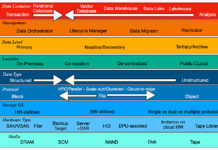Micron told the Sanford C. Bernstein Operational Decisions Conference last week that it has 3D XPoint SSD and memory DIMM roadmaps. This will take the company into direct competition on all fronts with the Intel Optane portfolio – in a couple of years or so.
In a wide-ranging interview, CFO Dave Zinsner said (transcript): “We want to continue to build out a portfolio for 3D XPoint.” He noted the technology “has some pretty interesting use cases particularly in the AI space.”
Zinsner’s remarks will resolve any ambiguity concerning Micron’s resolve to build and market 3D XPoint product on its own account. Many industry observers have questioned its commitment on this score. For instance, the technology analyst Jim Handy wrote last year that Micron might “desire to extricate itself from the 3D XPoint business while still satisfying alternate-sourcing agreements made by the company prior to XPoint’s 2015 introduction”.
Zinsner said the company is working with some of the “really big players in the space with this technology. The early read has been very positive, quite honestly, about it. But like all emerging technologies, adoption takes some time to get the use cases to the right place and get the cost and the performance at the right place… but we’re optimistic we’ll get there.”

Micron currently builds 3D XPoint dies for Intel’s Optane 200 series products and Micron’s own X100 SSDs, which launched in October 2019.
This “was just kind of a teaser product to get it out there, “Zinsner said, “and there’s certainly a road map of products, both continued road map on SSDs, but also a road map on the memory front. And I think we should look for those products coming over the next couple of years.” At that point Micron will have second generation XPoint SSDs and also XPoint DIMMs.
Intel Optane 200 series products use generation 2 (4-deck) XPoint, launched in June, but it is unclear if Micron’s X100 SSDs have moved yet from gen 1 to gen 2 XPoint.
In reply to question about their status, Zinsner said: “We’re in really early stages… then we got to continually move to better generations that have better cost structure and also hopefully increase the performance.”
This implies the addition of more layers so that the cost per XPoint bit goes down. Zinsner declined to discuss layer counts on the call.
Zinsner said Micron still have not had any meaningful revenue outside of wafers that we’re selling to our prior partner in 3D XPoint, Intel… I think for the next couple of years, it’s probably not going to be a meaningful portion of our revenue as we kind of build out the portfolio and work on the cost side of things. But eventually, we’re fairly optimistic about this business.”
Micron’s XPoint fab is currently under-utilised, which affects costs: “We peaked out at around $155m or so in the third quarter [to end August] of underload charges associated with that fab. They were down in the fourth quarter to more like $135m. They’ll probably be down again in the first quarter [which finishes at the end of February 2021].”








